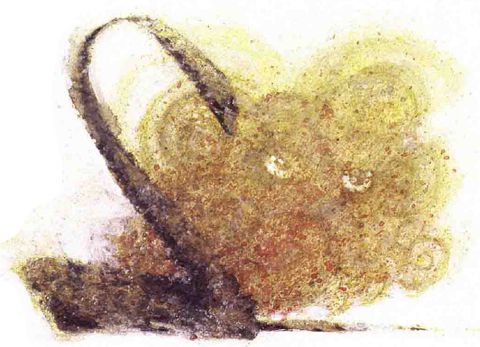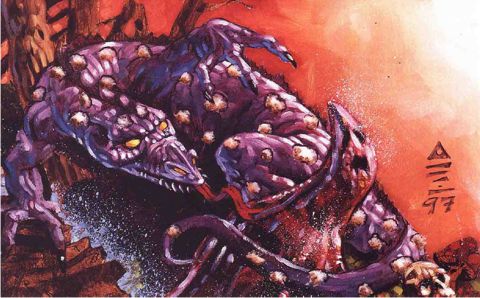Ash Quasielemental
In the mostly lifeless expanse that is the Quasiplane of Ash, the ash quasielemental embodies the slow fading of energy that has already consumed all it can. An animate pile of ashes and cinders, the quasielemental can form itself into crude shapes – a humanoid being, a serpentine creature, and so on.
Combat: This monster rarely makes attacks; its mere presence is threat enough. See, the ash quasielemental feeds on heat, forever sucking the warmth from all things around it. Anyone within 30 feet of the creature automatically suffers 1d6 points of damage per round. The quasielemental doesn’t need to make an attack roll, and the victim doesn’t get to make a saving throw. Creatures of cold – such as undead, white dragons, and frost salamanders – suffer no harm from the ash quasielemental’s heat-draining effect. Note, however, that merely being cold-blooded doesn’t protect a victim.
If it so chooses, the ash quasielemental can focus its draining effect into a conelike area 60 feet long and 30 feet wide at the base. Those within the cone suffer 2d6 points of damage per round from the loss of body heat. What’s more, this attack can extinguish a normal flame, such as a torch or a campfire.
If the ash quasielemental actually touches a sod in combat, its heat drain inflicts 1d6 points of damage plus 1 additional point per Hit Die of the elemental creature (6, 9, or 12). Note that the victim also suffers the normal damage from being within 30 feet of the quasielemental – the radius effect requires no effort on the monster’s part (unless it’s focusing the draining power into a cone).
Ash quasielementals can be struck only by +1 or better weapons and are immune to cold-based attacks. Oddly, though they drain warmth, a great amount of heat weakens them, as they can absorb only so much. Thus, all fire-based attacks inflict twice their normal damage. If an ash quasielemental is destroyed by fire, it explodes, inflicting 1d4 points of damage per Hit Die on all creatures within 30 feet.
Habitat/Society: Ash quasielementals rarely leave their home plane. The Elemental Plane of Fire would prove lethal to them, and most other planes are either too hot (causing them harm) or too cold (ofrering no sources of warmth they can drain).
The Quasiplane of Ash holds a gigantic fortress made of cinders, a palace known as the Citadel of Former Flame. From here, a council of powerful, intelligent ash quasielementals plots and plans against their enemies from Fire. While they can’t take direct action against the inhabitants of that plane for fear of their own destruction, they weave elaborate schemes that cause others to strike against their foes. Apparently, the council feels that with the eventual end of Fire, all that will be left is cold Ash.
Ecology: These creatures live a strange existence. After all, they must fear what they crave, for too much will destroy them. They’re not born through any sort of biological reproductive process, but seem to emerge randomly from the ash of the quasiplane. And only the most leatherheaded prime still believes the old rumor that ash quasielementals’re actually undead fire elementals.
Dust Quasielemental

If the ash quasielemental embodies the death of energy, then its dust counterpart embodies the death of matter. It revels in the obliteration of solid objects, especially the pulverization of worked or crafted materials. A dust quasielemental looks like a billowing cloud of dust, with tiny, eyelike pockets of swirling particles.
Combat: When fighting, a dust quasielemental can lash out with a pseudopod of churning dust, inflicting upon a foe 1d6 points of damage plus 1 additional point for each of its Hit Dice (6, 9, or 12).
However, if the quasielemental makes an unmodified (natural) attack roll of 19 or 20, it completely engulfs its opponent. Engulfed sods are powerless to act and begin disintegrating – their body’s particles blend with those already swirling within the monster. Victims suffer 2d6 points of damage per round until they die, at which point they’ve been completely broken down. A quasielemental can engulf only one creature of size S or M at a time. If a sod’s engulfed, the only way to free him is to kill the quasielemental.
The monster can also transform its body into a raging dust storm with a radius of 40 feet. Those caught within the storm must make a successful saving throw versus rod/staff/wand or become blinded for 1d10 rounds. However, nothing can save them from the storm’s physical battering, which causes 1d2 points of damage per Hit Die of the quasielemental.
A dust quasielemental can be struck only by weapons of +1 or greater enchantment.
Habitat/Society: Vengeful and destructive, dust quasielementals could almost be considered evil. Ultimately, of course, they must be seen as a natural part of the multiverse, rather than as creatures of malice. Nevertheless, if crossed, a dust quasielemental stops at nothing to slay the berk who did it harm. (Actually, if a cutter really thinks about it, the monsters’ affinity for destroying things that others have taken pains to create might also seem a bit immoral…)
Dust quasielementals have no real organization, although they sometimes gather in leaderless groups – mobs, really – to roam about wreaking havoc. They don’t willingly leave their home quasiplane, but when they suddenly find themselves somewhere else (perhaps because of a summoning), they take no steps to return. They’re simply content to break down matter wherever they happen to be.
Ecology: Because they literally feed upon destruction, dust quasielementals are best feared and avoided, rather than dealt with. To make matters worse, the creatures’re spontaneously generated wherever great devastation occurs, so their own actions tenth to create more of their kind.
Salt Quasielemental

Like the crystalline facets, other natives of the Quasiplane of Salt, the salt quasielementals absorb moisture of any sort. They’re not as numerous as the constantly multiplying facets, though, especially in the border areas between Salt and the Elemental Plane of Water. They can take on other appearances (as can certain other quasielementals), but these salt beings most often resemble large, white, rime-encrusted lizards.
Combat: Using their large, dense fists, salt quasielementals can smack their foes and cause 1d8 points of damage plus 1 additional point per Hit Die (6, 9, or 12). But they pose an even greater danger to any beings that contain water – which includes most animal and plant life, creatures of elemental water, and so on. The quasielementals automatically leech moisture from anything within 80 feet, and this draining effect inflicts 2d6 points of damage per round on susceptible creatures.
’Course, a body knows what’s said about too much of a good thing. If a salt quasielemental encounters so much water that it’s entirely immersed, it dies, exploding with great force. Everything within 30 feet of the creature is subject to an attack (as if the quasielemental itself had made it). Those struck suffer 1d8 points of damage from flying salt shrapnel.
Salt quasielementals can be struck only by weapons of +1 or greater enchantment. They’re also immune to fire.
Habitat/Society: The salt quasielementals stick mostly to their own plane. Fact is, they’ll never join the facets’ crusade against the Elemental Plane or Water, due to the dangers they’d face from being near such large volumes of liquid. More or less solitary creatures, salt quasielelementals’re content to wander their plane, absorbing water in small amounts.
It’s interesting to note that while a salt quasielemental can drain the moisture from a facet, the process doesn’t work in reverse – a facet can’t absorb anything from a salt quasielemental. This just goes to show that the quasielemental is truly the embodiment of salt (and dryness), while the facet is just a creature of salt.
Ecology: Chant is that a few high-up wizards have figured out a way to imprison salt quasielementals in their laboratories to keep their spellbooks and delicate experiments dry.
Vacuum Quasielemental
While some graybeards like to categorize these creatures as the embodiment of the destruction or absence of air, a truly canny blood knows the real dark – vacuum quasielementals embody the absence of everything. The things’re completely invisible, and their shape is that of an amorphous, rubbery, hollow skin.
Combat: A vacuum quasielemental can ram foes with its shapeless body, inflicting 1d4 points of damage plus 1 additional point per Hit Die (6, 9, or 12). But more importantly, it also draws any surrounding air into itself. An area of 60 feet around the creature is treated as though a continual gust of wind spell blew toward the quasielemental. Any air-breathing sod within that area automatically suffers 1d4 points of damage per round – the monster literally sucks the breath away from him. (’Course, this doesn’t apply on an airless void like the Quasiplane of Vacuum.)
If in a confined space, a vacuum quasielemental can reduce a 60-foot cube of air to a vacuum within a single round. However, it can maintain the airless state for only 10 rounds; it must then stop and rest for an hour before using this power again.
Like all quasielemental beings, vacuum quasielementals can be struck only by +1 or better weapons. Air-based spells (such as gust of wind) cast by a wizard or priest of a level higher than the quasielemental’s total Hit Dice slay the creature if it fails a saving throw versus death magic.
Habitat/Society: Vacuum quasielementals are surprisingly gregarious creatures, gathering in small groups whenever possible to converse and interact. On the other hand, they have no love for any other beings and usually attack intruders on their quasiplane.
Like their cousins of salt, vacuum quasielementals prefer to remain on their home plane. Sure, every elemental feels a certain level of discomfort when in an alien environment, but vacuum quasielementals actually dislike using their absorption abilities, which physically tire them.
Ecology: Much about vacuum quasielementals remains dark. Fact is, no one really knows how they sustain themselves; it’s just conjecture that they feed upon the air they draw into themselves. They may not need anything at all to survive. Or perhaps, like the strange egarus fungi also found on the Quasiplane of vacuum, the creatures literally survive on nothing – that is, nothingness.

